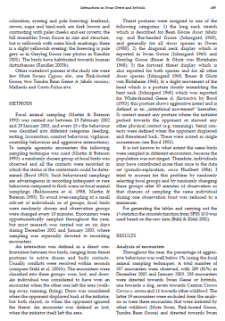- Search in all Repository
- Literature and maps
- Archeology
- Mills database
- Natural sciences
Advanced search
Advanced search
Advanced search
Advanced search
Advanced search

Object
Title: Ground nesting in recultivated forest habitats - a study with artificial nests
Creator:
Purger, Jenö J. (1961– ) ; Mészáros, Lídia Anna ; Purger, Dragica ; Polska Akademia Nauk. Muzeum i Instytut Zoologii
Date issued/created:
Resource type:
Subtitle:
Acta Ornithologica, vol. 39, no. 2 ; Presja drapieżników na lęgi ptaków gniazdujących na ziemi na terenach objętych rekultywacją - badania przy użyciu sztucznych gniazd ; Artificial ground nest survival
Contributor:
Museum and Institute of Zoology, Polish Academy of Sciences
Publisher:
Place of publishing:
Description:
Bibliogr. p. 144-145 ; P. [137]-145 : ill. ; 27 cm ; Abstarct in Polish
Type of object:
Abstract:
The study was carried out in the outskirts of the town of Pécs (southern Hungary) in a recultivated former coal mine. Bordered by Turkey Oak forests, this open area forms a wedge-shaped clearing in that woodland. Since trees and taller shrubs are rare in the area, it is mainly ground nesting bird species that occur in the clearing. In order to discover whether it is more advantageous to nest in the recultivated area (clearing) than in the nearby forest or at its edges, 150 artificial ground nests were constructed. On 7 May 2002, one quail egg and a plasticine egg of similar size were placed in each of the artificial nests. After a week it was found that 24% of nests in the clearing, 30% of those in the forest edge, and 44% of the ones inside the forest had suffered depredation. The proportions of damaged plasticine and quail eggs inside the forest and at the forest edge were similar, whereas the quail eggs in the clearings were significantly less damaged than plasticine eggs. Of all the experimental eggs, significantly more plasticine eggs (29%) were damaged than quail eggs (17%), which suggests that small-bodied predators are unable to break the quail eggs. 18% of the plasticine eggs attacked, and 72% of the quail eggs attacked were removed from the nest by the predator. Among the predators, small mammals were dominant in the clearing and inside the forest, and birds at the forest edge. Based on the predation of quail eggs, the survival chances of ground nests in the clearing are greater than at the forest edge or inside the forest.
Relation:
Volume:
Issue:
Start page:
End page:
Detailed Resource Type:
Format:
Resource Identifier:
Source:
MiIZ PAN, call no. patrz sygn. czas. P.257-39-2 ; MiIZ PAN, call no. patrz sygn. czas. P.4568-39-2 ; click here to follow the link
Language:
Rights:
Terms of use:
Copyright-protected material. May be used within the limits of statutory user freedoms
Digitizing institution:
Museum and Institute of Zoology of the Polish Academy of Sciences
Original in:
Library of the Museum and Institute of Zoology of the Polish Academy of Sciences
Projects co-financed by:
Programme Innovative Economy, 2010-2014, Priority Axis 2. R&D infrastructure ; European Union. European Regional Development Fund
Access:
Object collections:
- Digital Repository of Scientific Institutes > Partners' collections > Museum and Institute of Zoology PAS > Scientific Journals
- Digital Repository of Scientific Institutes > Partners' collections > Museum and Institute of Zoology PAS > MIZ PAN Publications > Acta Ornithologica
- Digital Repository of Scientific Institutes > Literature > Journals/Articles
Last modified:
Feb 4, 2025
In our library since:
Jul 28, 2015
Number of object content downloads / hits:
36
All available object's versions:
https://rcin.org.pl./publication/49784
Show description in RDF format:
Show description in RDFa format:
Show description in OAI-PMH format:
| Edition name | Date |
|---|---|
| Ground nesting in recultivated forest habitats — a study with artificial nests / Purger J. J., Mészáros L. A. | Feb 4, 2025 |
Objects Similar
Wysocki, Dariusz (1961– ) Polska Akademia Nauk. Muzeum i Instytut Zoologii
Antonov, Anton (1977–2012) Polska Akademia Nauk. Muzeum i Instytut Zoologii
Mazgajski, Tomasz D.
Báldi, András (1965– ) Batáry, Péter
Wysocki, Dariusz
Winton, Bryan Reno Leslie, David M.
Walankiewicz, Wiesław
Poulin, Brigitte (1962– ) Lefebvre, Gaëtan (1962– ) Metref, Slimane

 INSTYTUT ARCHEOLOGII I ETNOLOGII POLSKIEJ AKADEMII NAUK
INSTYTUT ARCHEOLOGII I ETNOLOGII POLSKIEJ AKADEMII NAUK
 INSTYTUT BADAŃ LITERACKICH POLSKIEJ AKADEMII NAUK
INSTYTUT BADAŃ LITERACKICH POLSKIEJ AKADEMII NAUK
 INSTYTUT BADAWCZY LEŚNICTWA
INSTYTUT BADAWCZY LEŚNICTWA
 INSTYTUT BIOLOGII DOŚWIADCZALNEJ IM. MARCELEGO NENCKIEGO POLSKIEJ AKADEMII NAUK
INSTYTUT BIOLOGII DOŚWIADCZALNEJ IM. MARCELEGO NENCKIEGO POLSKIEJ AKADEMII NAUK
 INSTYTUT BIOLOGII SSAKÓW POLSKIEJ AKADEMII NAUK
INSTYTUT BIOLOGII SSAKÓW POLSKIEJ AKADEMII NAUK
 INSTYTUT CHEMII FIZYCZNEJ PAN
INSTYTUT CHEMII FIZYCZNEJ PAN
 INSTYTUT CHEMII ORGANICZNEJ PAN
INSTYTUT CHEMII ORGANICZNEJ PAN
 INSTYTUT FILOZOFII I SOCJOLOGII PAN
INSTYTUT FILOZOFII I SOCJOLOGII PAN
 INSTYTUT GEOGRAFII I PRZESTRZENNEGO ZAGOSPODAROWANIA PAN
INSTYTUT GEOGRAFII I PRZESTRZENNEGO ZAGOSPODAROWANIA PAN
 INSTYTUT HISTORII im. TADEUSZA MANTEUFFLA POLSKIEJ AKADEMII NAUK
INSTYTUT HISTORII im. TADEUSZA MANTEUFFLA POLSKIEJ AKADEMII NAUK
 INSTYTUT JĘZYKA POLSKIEGO POLSKIEJ AKADEMII NAUK
INSTYTUT JĘZYKA POLSKIEGO POLSKIEJ AKADEMII NAUK
 INSTYTUT MATEMATYCZNY PAN
INSTYTUT MATEMATYCZNY PAN
 INSTYTUT MEDYCYNY DOŚWIADCZALNEJ I KLINICZNEJ IM.MIROSŁAWA MOSSAKOWSKIEGO POLSKIEJ AKADEMII NAUK
INSTYTUT MEDYCYNY DOŚWIADCZALNEJ I KLINICZNEJ IM.MIROSŁAWA MOSSAKOWSKIEGO POLSKIEJ AKADEMII NAUK
 INSTYTUT PODSTAWOWYCH PROBLEMÓW TECHNIKI PAN
INSTYTUT PODSTAWOWYCH PROBLEMÓW TECHNIKI PAN
 INSTYTUT SLAWISTYKI PAN
INSTYTUT SLAWISTYKI PAN
 SIEĆ BADAWCZA ŁUKASIEWICZ - INSTYTUT TECHNOLOGII MATERIAŁÓW ELEKTRONICZNYCH
SIEĆ BADAWCZA ŁUKASIEWICZ - INSTYTUT TECHNOLOGII MATERIAŁÓW ELEKTRONICZNYCH
 MUZEUM I INSTYTUT ZOOLOGII POLSKIEJ AKADEMII NAUK
MUZEUM I INSTYTUT ZOOLOGII POLSKIEJ AKADEMII NAUK
 INSTYTUT BADAŃ SYSTEMOWYCH PAN
INSTYTUT BADAŃ SYSTEMOWYCH PAN
 INSTYTUT BOTANIKI IM. WŁADYSŁAWA SZAFERA POLSKIEJ AKADEMII NAUK
INSTYTUT BOTANIKI IM. WŁADYSŁAWA SZAFERA POLSKIEJ AKADEMII NAUK




































